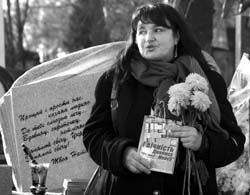James Mace: candle of memory

The historian James Ernest Mace (Feb. 18, 1952 — March 3, 2004), an Oklahoma-born American from the Cherokee tribe, devoted his life to the thorough study of the Ukrainian Apocalypse of 1932-33. He examined its background, course, the totalitarian strategy of Stalin’s regime, and the disastrous consequences of this unprecedented crime for future generations of Ukrainians.
James Mace was the first person in the world to substantiate and prove the genocidal character of the Holodomor. And had he done only this — he was also an activist in Ukraine, staff writer for The Day from January 1998 until the last days of his life, and a professor at Kyiv-Mohyla Academy — even then he would deserve the indisputable right to be remembered forever by the Ukrainian people.
The ceremony of unveiling and blessing Volodymyr Korin’s monument to Mace was held at his gravesite on Nov. 18. Quite a few people gathered in a far corner of Baikove Cemetery: James’s relatives and close friends, colleagues, scholars, journalists, representatives of the Presidential Secretariat, and members of the public. Expressing their sincere condolences to Mace’s widow, the writer Natalia Dziubenko-Mace, for whom time has not eased the pain of her irretrievable loss, the participants of the meeting in Mace’s memory said that the candle of sorrow, lit by him, is still burning in our hearts.
The Day’s editor in chief Larysa Ivshyna called on the participants to reflect on the question: “Why did this son of far-away Oklahoma become so inspired by the Ukrainian land’s pain?” “Because he had a heart of gold and an acute sense of injustice, abhorrence of evil, and a restless conscience,” Ivshyna declared.
“When James joined The Day, I had a feeling that a mighty “second front” had just been opened. It is still continuing, although James left us two and a half years ago. In my opinion, one of Mace’s most important lessons was that we must not be afraid of pain and not forget that when millions and millions of our brothers and sisters were dying a terrible excruciating death in Ukrainian villages, many urban residents were eating their sandwiches. This was another attempt to disunite us. Let us not forget this — for every sin must be expiated...Only then will deep unification come. Thank you to James for the lesson of truth that he taught us!”
Stanislav Kulchytsky, a leading Ukrainian historian of the Holodomor, who was closely acquainted with Mace, said that more and more James is becoming a kind of symbol of purification. The unveiling of a monument on his gravesite also had great symbolic meaning because to this day there is only one official monument to the victims of the Holodomor — the cross on Mykhailivska Square. We have no right to forget, Kulchytsky said, that the Holodomor tragedy, which had been concealed for roughly six decades, was revealed first of all thanks to Mace’s efforts as the executive director of the US Congressional Commission on the Holodomor. But to a great extent our society still does not understand what occurred in 1932-33. So it is our duty to convey this terrible truth to everyone; Mace’s short life was devoted namely to this.
Among the other speakers were Professor Natalia Shulha of Kyiv-Mohyla Academy, who noted bitterly that the world’s academic community still does not know the whole truth about the Holodomor tragedy, and said this about Mace: “He was a man with a poet’s soul, and ‘the world’s fissure,’ to quote Heine, pierced his heart”; the outstanding Ukrainian poet Ivan Drach, who shared his recollections of his meetings with James, their visits to Telizhyntsi, Drach’s native village, half of whose population starved to death during the famine; Natalia Sukhodolska, executive director of the Association of Holodomor Researchers; the writers Lesia Stepovychka and Anatolii Kachan; and Professor Mykhailo Naienko of Taras Shevchenko Kyiv State University, who said that James Mace’s cause is not over yet.
We still have to learn one more terrible truth: why did such an unprecedented terror as the Holodomor happen? Was it not because the totalitarian regime foisted its antihuman values on society? Has this legacy been overcome?
On Nov. 17, 2006, the Verkhovna Rada refused to consider the question of recognizing the Holodomor of 1932-33 as genocide against the Ukrainian nation.
Not everyone present knew that James was very fond of the famous Ukrainian folksong (and one of the saddest) “Za bairakom bairak” (A Ravine beyond the Ravine), which contains the following words: “Here three hundred of us perished like glass...” The song was performed by kobza player Stepan Shcherbak. Afterwards, everyone silently remembered Jim and gazed at the monument on which a fragment of a poem by Natalia Dziubenko-Mace is engraved:
Adieu! And forgive us, my beloved,
Like a tear to you I will fly...
Ukraine, light the candle,
A widow’s, an orphan’s imperishable light
Ukraine, light the world!






